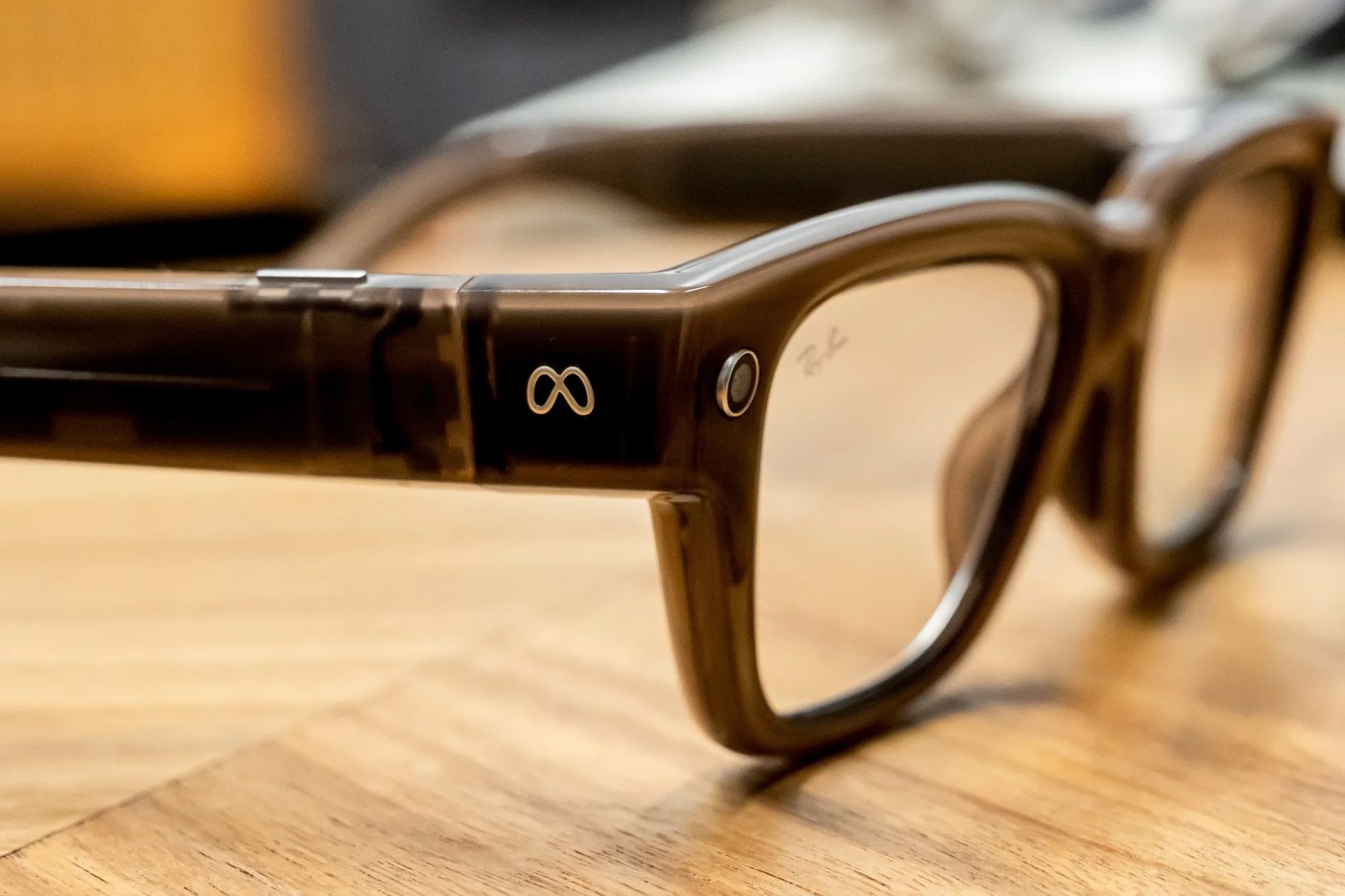By Mark Gurman, Bloomberg
Meta Platforms Inc., seeking to turn its smart glasses lineup into a must-have product, on Wednesday unveiled its first version with a built-in screen.
The latest model, the $799 Meta Ray-Ban Display, features a screen in the right lens. It can show text messages, video calls, turn-by-turn directions in maps and visual results from queries to Meta’s AI service. The subtly integrated display can also serve as a viewfinder for the camera on a user’s phone or surface music playback.
Related Articles
Abortion advocates raise alarm about social platforms removing posts in apparent overreach
Facebook’s settlement payments are going out
Meta, OpenAI face FTC inquiry on chatbot impact on kids
Apple’s lead AI researcher for robotics heads to Meta as part of latest exits
Big tech’s market dominance stirs debate on concentration risks
Speaking at the company’s annual Meta Connect event, Chief Executive Officer Mark Zuckerberg said Meta’s future glasses will be a vehicle for “superintelligence,” a term he has adopted to describe advanced artificial intelligence development and the name of a team inside the company.
“AI should serve people, not just be something that sits in a data center, automating large parts of society,” he said Wednesday from the stage at Meta’s Menlo Park, California headquarters.
For smart glasses — or AI glasses, as Meta now calls them — a display is key. The addition, over time, could allow consumers to offload some functionality to their eyewear that they would normally expect their phones to handle.
In an interview ahead of their launch, Chief Technology Officer Andrew Bosworth called the new glasses “the first serious product” in the space. This launch is a key part of Meta’s effort to build its own consumer electronics ecosystem, positioning itself against rivals like Apple Inc. and Alphabet Inc.’s Google. Since debuting its first virtual reality headset in 2016, Meta has aimed to attract users away from the dominant platforms.
“This feels like the kind of thing where you can start to keep your phone in your pocket more and more throughout the day,” Bosworth said. He added that the phone isn’t going away, but glasses offer a more convenient way to access its most popular features.
The glasses introduce a new control system. While users can still swipe along the frame as with previous models, the primary interface is now hand gestures, detected by a neural wristband strapped around the wearer’s dominant hand.
The user can select items by pinching their thumb and index finger, swipe through items by sliding a thumb across their gripped hand, double tap their thumb to invoke Meta’s AI voice assistant, or twist their hand mid-air to adjust music volume and other controls.
In addition to app interactions and the ability to handle AI queries, the glasses include a live caption feature that displays spoken words in real time — including translations — similar to closed captions on a TV. The video calling function lets wearers see the person they’re speaking with while sharing their own point of view.
Users can reply to texts by sending an audio recording or dictating a response. Later this year, the wristband will add another option: handwriting words in the air. A future update will also let the glasses focus on the person a wearer is speaking with while filtering out background noise.
The new glasses will go on sale Sept. 30 and will include the wristband. Meta is offering two sizes and two color options: black and a brown shade called sand. They will be sold by EssilorLuxottica SA’s Ray-Ban, Lenscrafters International Inc., Best Buy Co. and a limited number of Verizon Communications Inc. locations.
At launch, they’ll support apps like Facebook Messenger, WhatsApp and a music app powered by Spotify Technology SA. The Instagram app will initially only support direct messages, but Meta plans to add Reels viewing later this year.
The glasses’ display offers a limited 20-degree field of view with a resolution of 600 x 600 pixels. Its brightness ranges from 30 to 5,000 nits, providing decent visibility in most outdoor conditions, though it can struggle in the brightest sunlight. Some prescriptions are supported, but only as a built-to-order option.
The external camera matches past Ray-Ban glasses with a 12-megapixel sensor but falls short of new non-display models, also introduced Wednesday, in video resolution and battery life. The glasses record 1080p video and last six hours per charge, with the external case providing an additional 30 hours — roughly four full recharges.
Zuckerberg attempted live demos of a new version of the company’s Ray-Ban Meta glasses and the AI display glasses from the stage on Wednesday, but experienced technical difficulties with both.
“You practice these things a hundred times,” Zuckerberg quipped.
The wristband, called the Meta Neural Band, comes in three sizes and offers 18 hours of battery life. At launch, Meta is steering buyers to retail stores for proper fitting and onboarding before eventually selling the glasses online.
Glasses Partnership
Beyond the engineering, branding and partnerships were also a challenge. Meta’s partner EssilorLuxottica initially hesitated to put the Ray-Ban brand on the display glasses, setting off a race for the social network to win over its longtime partner.
“The truth is, when we started this thing, Ray-Ban wasn’t even sure it would look good enough to be a Ray-Ban product,” Bosworth said. “It was just going to be Meta display glasses. And we did a ton of work to get it into a place that they felt like ‘oh wow, OK, we can see this actually being a Ray-Ban product.’”
Then there’s the $799 price, which is about as much as a smartphone that needs to be paired with the glasses costs. “Does it survive first contact with the market is the real question,” Bosworth said. “We’re feeling really confident with where this product is.”
The social networking giant has invested billions in hardware, betting that glasses will become a primary way users experience Meta’s AI products and social services. Meta recently made a $3.5 billion investment in EssilorLuxottica, taking about a 3% equity stake.
“We’re investing a lot of money,” Bosworth said. “We do think it is an investment that we expect to make a return on investment from. We do think we can get there on the hardware side, as well as on software and services.” he added.
New Screen-Free Models
The new screen-free models are an updated version of its standard smart Ray-Bans and a new offering under the Oakley brand. That continues a push from June, when the company introduced the higher-end Oakley HSTN smart glasses.
The new Ray-Bans come in colors like navy blue, add 3K video recording (up from 1080p resolution on the previous models) and offer 40% more battery life. Notably, Meta raised the starting price of the updated model to $379, up from $299, citing components and desire for margins rather than tariffs. The cheaper previous-generation model will continue to be sold.
The company also launched the Meta Oakley Vanguard, a sports-focused design that wraps around the wearer’s face and includes improved water resistance. The glasses feature a centered camera, louder speakers with deeper bass and new shooting modes such as 60-frames-per-second video, slow-motion and time-lapse capture.
Bosworth said the Vanguard edition may eventually gain another feature: the ability to function like a walkie-talkie. For example, a group of users could go snowboarding together and communicate without placing traditional phone calls.
Market Potential
The new display glasses serve as a stepping stone to full augmented reality, or AR, glasses — immersive eyewear that overlays interactive content across both lenses. Meta is developing its first consumer AR glasses for a planned 2027 release, Bloomberg News has reported.
While Meta is the dominant player in this space and the first major consumer brand to bring display glasses to market, it’s not the first to try — and rivals are close behind.
“Google Glass was here first and in some ways was a great product,” Bosworth said. “Timing is everything, right? And there are no bad ideas in Silicon Valley, just bad timing.” The $1,500 Google version debuted in 2012, falling flat due to its price, features and privacy concerns.
Meta is likely to face future competition from the search engine giant, Samsung Electronics Co. and Apple, which is planning to unveil its first glasses as early as next year. Chinese startups like Xreal Inc. are also moving quickly into the market.
Bosworth predicts Meta will sell over 100,000 units of the display glasses by the end of next year and expects the company to sell every unit it makes. “We really feel like we’ve captured something, a zeitgeist, at the right time with the AI boom coming,” he said.
“We really wanted to bias these in favor of the people who are going to actually put them on and use them,” Bosworth said, referring to the glasses as a low-volume product, “rather than technology enthusiasts who may buy them just to have and not really use them.”
Alex Himel, who leads the glasses work under Bosworth, said in a separate interview that he believes AI glasses will gain “mainstream traction” by the end of the decade.
Future Bets
Bosworth is already exploring future display models, including versions with cellular connectivity and binocular displays (screens in both lenses). He envisions multiple offerings across non-display, display and AR segments.
He also sees potential for a dedicated app store but cautioned that it isn’t imminent, since running it would require an upgrade from the Qualcomm Inc. component used in the first-generation model.
“We don’t have the compute space right now to run arbitrary software,” he said, referring to non-essential apps. (The non-display glasses, however, are now being opened up to developers.)
At the same time, the bigger picture here may be moving away from apps altogether and just using the AI to get things done. “AI is a tremendously good solution” to replacing the litany of apps that people download to their gadgets today, Bosworth said.
Looking beyond glasses, Bosworth said his group, known as Reality Labs, is experimenting with several other form factors.
He revealed the company has “gotten pretty far down the path” of launching a smart watch to compete with Apple and that he’s considering some “pretty promising” prospects. “We’ve had some pretty exciting experience breakthroughs the last couple of weeks,” he said.
Looking even further down the road, Himel said the company has researched contact lenses that could, one day, replace glasses for providing AR. But such an offering may never arrive given the technological barriers. “There isn’t anything we’re not looking at.”
–With assistance from Kurt Wagner and Vlad Savov.
More stories like this are available on bloomberg.com
©2025 Bloomberg L.P.





